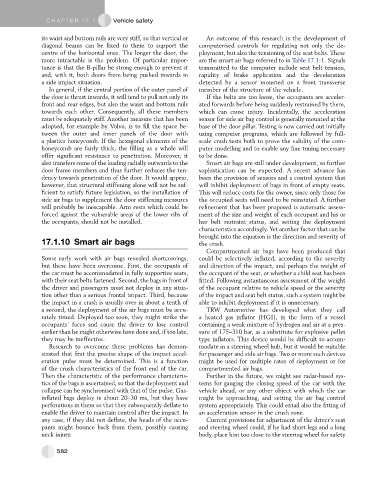Page 571 - Automotive Engineering Powertrain Chassis System and Vehicle Body
P. 571
CHAP TER 1 7. 1 Vehicle safety
its waist and bottom rails are very stiff, so that vertical or An outcome of this research is the development of
diagonal beams can be fixed to them to support the computerised controls for regulating not only the de-
centre of the horizontal ones. The longer the door, the ployment, but also the tensioning of the seat belts. These
more intractable is the problem. Of particular impor- are the smart air bags referred to in Table 17.1-1. Signals
tance is that the B-pillar be strong enough to prevent it transmitted to the computer include seat belt tension,
and, with it, both doors from being pushed inwards in rapidity of brake application and the deceleration
a side impact situation. detected by a sensor mounted on a front transverse
In general, if the central portion of the outer panel of member of the structure of the vehicle.
the door is thrust inwards, it will tend to pull not only its If the belts are too loose, the occupants are acceler-
front and rear edges, but also the waist and bottom rails ated forwards before being suddenly restrained by them,
towards each other. Consequently, all these members which can cause injury. Incidentally, the acceleration
must be adequately stiff. Another measure that has been sensor for side air bag control is generally mounted at the
adopted, for example by Volvo, is to fill the space be- base of the door pillar. Testing is now carried out initially
tween the outer and inner panels of the door with using computer programs, which are followed by full-
a plastics honeycomb. If the hexagonal elements of the scale crash tests both to prove the validity of the com-
honeycomb are fairly thick, the filling as a whole will puter modelling and to enable any fine tuning necessary
offer significant resistance to penetration. Moreover, it to be done.
also transfers some of the loading radially outwards to the Smart air bags are still under development, so further
door frame members and thus further reduces the ten- sophistication can be expected. A recent advance has
dency towards penetration of the door. It would appear, been the provision of sensors and a control system that
however, that structural stiffening alone will not be suf- will inhibit deployment of bags in front of empty seats.
ficient to satisfy future legislation, so the installation of This will reduce costs for the owner, since only those for
side air bags to supplement the door stiffening measures the occupied seats will need to be reinstated. A further
will probably be inescapable. Arm rests which could be refinement that has been proposed is automatic assess-
forced against the vulnerable areas of the lower ribs of ment of the size and weight of each occupant and his or
the occupants, should not be installed. her belt restraint status, and setting the deployment
characteristics accordingly. Yet another factor that can be
brought into the equation is the direction and severity of
17.1.10 Smart air bags the crash.
Compartmented air bags have been produced that
Some early work with air bags revealed shortcomings, could be selectively inflated, according to the severity
but these have been overcome. First, the occupants of and direction of the impact, and perhaps the weight of
the car must be accommodated in fully supportive seats, the occupant of the seat, or whether a child seat has been
with their seat belts fastened. Second, the bags in front of fitted. Following instantaneous assessment of the weight
the driver and passengers must not deploy in any situa- of the occupant relative to vehicle speed or the severity
tion other than a serious frontal impact. Third, because of the impact and seat belt status, such a system might be
the impact in a crash is usually over in about a tenth of able to inhibit deployment if it is unnecessary.
a second, the deployment of the air bags must be accu- TRW Automotive has developed what they call
rately timed. Deployed too soon, they might strike the a heated gas inflator (HGI), in the form of a vessel
occupants’ faces and cause the driver to lose control containing a weak mixture of hydrogen and air at a pres-
earlier than he might otherwise have done and, if too late, sure of 175–310 bar, as a substitute for explosive pellet
they may be ineffective. type inflators. This device would be difficult to accom-
Research to overcome these problems has demon- modate in a steering wheel hub, but it would be suitable
strated that first the precise shape of the impact accel- for passenger and side air bags. Two or more such devices
eration pulse must be determined. This is a function might be used for multiple rates of deployment or for
of the crush characteristics of the front end of the car. compartmented air bags.
Then the characteristic of the performance characteris- Further in the future, we might see radar-based sys-
tics of the bags is ascertained, so that the deployment and tems for gauging the closing speed of the car with the
collapse can be synchronised with that of the pulse. Gas- vehicle ahead, or any other object with which the car
inflated bags deploy in about 20–30 ms, but they have might be approaching, and setting the air bag control
perforations in them so that they subsequently deflate to system appropriately. This could entail also the fitting of
enable the driver to maintain control after the impact. In an acceleration sensor in the crush zone.
any case, if they did not deflate, the heads of the occu- Current provisions for adjustment of the driver’s seat
pants might bounce back from them, possibly causing and steering wheel could, if he had short legs and a long
neck injury. body, place him too close to the steering wheel for safety
582

